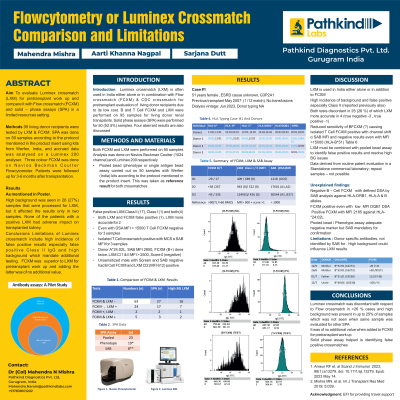Back

Flowcytometry or Luminex Crossmatch – Comparison and Limitations
(P619) Flowcytometry or Luminex crossmatch – Comparison and limitations
Location: Platinum Ballroom

Poster Presenter(s)
Aim: To evaluate Luminex crossmatch (LXM) for pretransplant work up and compare it with Flow crossmatch (FCXM) and solid – phase assays in a limited resources setting.
Method: Pre-transplant work up for 61 living donor recipients included LXM (n = 65), FCXM (n=58) and solid phase assays (n= 32). All solid phase assays were performed according to the protocol mentioned in the product insert using kits from Immucor, India, and accrued data was analysed on a Luminex 200 analyser. Cut off for assigning a positive result was MFI > 500 for LXM and score > 2. Three colour Flowcytometry crossmatch was done on the Navios Beckman Coulter Flowcytometer. FCXM cut offs for B Cell and T Cell positive were linear channel shift. > 90 and 60, respectively. A positive and negative sample or commercial control was included in each run for all the tests. Patients were followed up for 3-6 months after transplantation.
Results: Eighteen samples (27.7%) were LXM positive (Class I -1. Class II -14, Both-3), but FCXM negative. Verification by solid phase assays for eleven samples showed that they were all false positive. A negative FCXM and LXM was obtained for thirty-nine samples of which 21 were also negative by one or more bead-based assays. One sample was negative by LXM and SAB, but B cell FCXM was positive. A high background was observed. High background was seen in 26 (40%) samples that were processed for LXM, but it affected the results only in two samples. None of the patients with a positive LXM had adverse impact on transplanted kidney.
Conclusion: Limitations of Luminex crossmatch include high incidence of false positive results and high background which mandate use of pooled or phenotype bead assays. Flowcytometry crossmatch was adjudged to be superior to LXM for pretransplant work up and adding the latter was of no additional value.
Method: Pre-transplant work up for 61 living donor recipients included LXM (n = 65), FCXM (n=58) and solid phase assays (n= 32). All solid phase assays were performed according to the protocol mentioned in the product insert using kits from Immucor, India, and accrued data was analysed on a Luminex 200 analyser. Cut off for assigning a positive result was MFI > 500 for LXM and score > 2. Three colour Flowcytometry crossmatch was done on the Navios Beckman Coulter Flowcytometer. FCXM cut offs for B Cell and T Cell positive were linear channel shift. > 90 and 60, respectively. A positive and negative sample or commercial control was included in each run for all the tests. Patients were followed up for 3-6 months after transplantation.
Results: Eighteen samples (27.7%) were LXM positive (Class I -1. Class II -14, Both-3), but FCXM negative. Verification by solid phase assays for eleven samples showed that they were all false positive. A negative FCXM and LXM was obtained for thirty-nine samples of which 21 were also negative by one or more bead-based assays. One sample was negative by LXM and SAB, but B cell FCXM was positive. A high background was observed. High background was seen in 26 (40%) samples that were processed for LXM, but it affected the results only in two samples. None of the patients with a positive LXM had adverse impact on transplanted kidney.
Conclusion: Limitations of Luminex crossmatch include high incidence of false positive results and high background which mandate use of pooled or phenotype bead assays. Flowcytometry crossmatch was adjudged to be superior to LXM for pretransplant work up and adding the latter was of no additional value.

